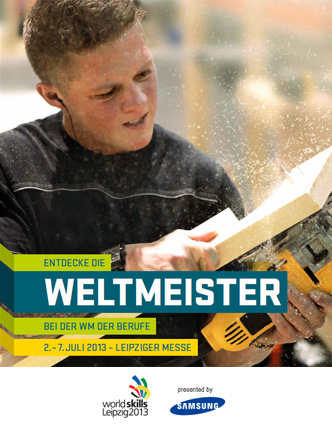Stonemasonry
Stone cutters and sculptors have greatly contributed to shaping the architectural styles of the past. While innovative technologies have significantly changed the job description, craftsmanship is still an essential aspect.
As an apprentice you will still learn to process stones in the classic style. At the end of your apprenticeship, the journeyman’s piece designed by you will be completed.
The work of a modern-day stone cutter encompasses a wide variety of activities. The trades range from quarry work to production, from stone cutting to lithotomy, from working on monuments to sculpting and from conservation to securing and building. Every facet requires a high level of traditional manual skills and basic knowledge.
Wall and Floor Tiling
Since 1935 Floor Tiling (Fliesenleger) is an approved trade in Germany.
Ceramic tiles, mosaics and natural stones are laid in indoor and outdoor areas, e.g. in wellness, living and industrial areas.
Along with your craftsmanship you can also fully employ your artistic creativity. It is your expertly executed work that gives the flooring its full value.
Plumbing and Heating
The System Mechanic for Sanitary, Heating and Air Conditioning
is responsible for the supply of heat and fresh air to private homes and offices–of course in an environmentally friendly and energy-saving manner. Furthermore, as a system mechanic, you will be responsible for the water and gas supply in residential buildings as well as in industrial facilities and will help in consulting and planning.
Installing sanitary facilities, programming of systems and emergency aid in case of technical problems are also part of your job. Fields of activity are water, air and thermal engineering, environmental technologies and renewable energies.
Electrical Installations
In order to become a technician in the field of Electrical Engineering with a specialisation in Automation Engineering,
you will need to expand your training to include various areas in electrical engineering as well as in mechanical engineering, plant engineering and nanotechnology.
As an Automation Engineer you will contribute to the development and composition of automation devices, automation plants and systems. Your tasks also encompass, among others, controlling the production process, supervising the assembly on site, conducting tests, developing test reports, analysing errors and presenting solution proposals.
Bricklaying
The field of activity of a Bricklayer
ranges from pouring concrete basement foundations to plastering walls. Your knowledge of the properties of artificial and natural stone, such as brick, sand-lime brick, pumice, concrete stones and gypsum plaster board, are the basis of your work. Additionally a bricklayer has to know how to deal with lime mortar and plaster, which provides constructions with the required stability. Erecting prefabricated segments according to specific execution plans is part of your job.
After completing initial training and gathering practical experience, you have the option to further qualify as an assistant foreman, foreman, certified foreman or master craftsman in bricklaying. Should you complete a vocational diploma, you can also take up architectural or civil engineering study at a technical college.
Plastering and Drywall Systems
Plastering includes the design and creative work for new buildings and in restoring existing buildings.
Outdoors your work includes designing building fronts, renovating and restoring historical buildings as well as scaffolding. Indoors you are responsible for the interior plaster, drywall and attic constructions, but also for the decorative design of the interiors and the choice of colouring.
Then there is also the development and design of buildings with gypsum materials and elements.
The German names within the dual training system are Stuckateur
(Plasterer) and Trockenbaumonteur (Drywall Constructor).
Painting and Decorating
As a Painter (Maler) you work on the outside and inside of buildings: For the purposes of preservation and maintenance, for sanitary and hygienic reasons, for decoration, lettering and for ensuring safety you are responsible for creating the colour scheme.
Cabinetmaking
Carpentry and Cabinet Making
centres around the processing of wood. While in the old days many processes were done manually, modern carpentry employs state-of-the-art computer-controlled machines. Carpentry is distinguished between two specialisations: carpentry and cabinet making.
If you specialise on cabinet making and interiors, you will mostly work in the workshop. Your main activities will include cutting, veneering, grinding, pickling, priming, painting and spraying wooden surfaces.
Joinery
As a Joiner (Bauschreiner) you will manufacture building elements and assemble them by means of wood joints. You fabricate doors, windows, staircases and other building elements and you also work outside of the workshop and cooperate with the customer and with people working in other trades. Your special knowledge comprises measuring and marking at the building site, laying out of plastic sheets, wood protection treatments, inserting of glass panes and installing isolation materials.
Carpentry
The expansion of the job description for a Carpenter
is related to the rapid development of building materials and systems as well as the tools, machines and plants. This development is particularly visible in the changes caused by the introduction of computerised construction and the way the production of wooden elements is organised.
Manufacturing wood constructions, including entire structures or building components made of wood, are your main tasks. These activities range from the building of roofs and individual wooden elements to the erection of buildings made entirely of wood including the interior.
A special aspect is the preservation of monuments and buildings, which opens up the opportunity to qualify as a carpenter for restoration work. The assembly of scaffolding, moulds and casing, wooden structures for gardening and landscaping as well as for marine applications round off your range of activities.
Landscape Gardening
Handling plants, paving stones, designing, creating and maintaining gardens, greening cities and protecting the environment: This is your diversified job as a Landscape Gardener.
It provides you with a lot of room for creativity. Your tasks include the design of outside areas near public and private buildings, the creation of parks and the green areas of city centres. Building and maintaining sports fields and playgrounds as well as golf courses and recreational areas are also your responsibility.
As a landscape gardener you will also be concerned with maintaining and designing gardens, terraces, driveways, roof greenings and pond systems.
After finishing training, your expert knowledge and capabilities are in demand in practical applications, for example as a foreman or site manager. After one year in the job you are eligible to expand your qualifications, e.g. as a technician.
Refrigeration
As a Refrigeration and Air Conditioning Technician (German description Mechatronics Technician for Refrigeration) you will be dealing with the installation, implementation, maintenance, fault-finding and repair of refrigeration systems, which transmit heat via a steam compression coolant circuit. This includes, for example, cooling systems used for cold and deep-freeze rooms, air conditioning, liquid coolers and heat pumps. The systems must be operated with a common HFC coolant (fluorocarbon polymers) or a widely used natural coolant.
Traditional Presentation Skill: Big Machinery
Construction Plant Operators operate construction equipment and machines in civil engineering, building construction and road construction. Prior to the commencement of the construction work, they transport cranes, bulldozers, rolling mills, excavators or batch mixers to the construction sites, ensure their serviceability and adjust them to the local conditions. Furthermore, it is their responsibility to secure the construction site.
They conduct and operate construction machines, e.g. they transport components, handle building materials and conduct excavation work. They also maintain the equipment, perform minor repairs and modify the equipment, if required (e.g. they may replace peripheral devices).
Traditional Presentation Skills: Pipeline Engineer
Pipeline Engineers construct and maintain pipelines for water, gas, oil or district heating. Before they lay the pipes, they excavate the pipe trenches and safeguard them. Afterwards, they sink the required segments of pipe into the trench. Standardized piping is used most of the time, but customized individual items such as bends and curvatures, which can not be ordered, are produced in the workshop by the pipeline engineers themselves.
In the trench, they will connect the segments into a resilient and leak-proof pipeline, which sometimes has to withhold high pressure. Depending on the material of the pipe, the segments will have to be welded, glued or bolted together. They also will build in branches, slide valves and measuring instruments. Afterwards they will also conduct leak tests and close the pipe trenches. Finally they will perform repairs and maintenance on the pipelines: e.g. they repair pipe bursts or connect households to supply mains.
Traditional Presentation Skill: Road Maker
Road Makers build roads, bicycle lanes, pedestrian areas as well as highways and runways. After marking off the construction site they start with groundworks. They strip ground mass, transport, grade and consolidate it. For this purpose they deploy excavators, caterpillars and rollers.
Mostly, they apply a layer of gravel and further rock layers on the consolidated ground. The process is completed with a layer of concrete or tarmac, which forms the roadway. Road Makers will also carry out cobble works and install surface drains and fortifications on steep roads and embankments. Apart from building new roads, Road Makers also perform road maintenance.






















